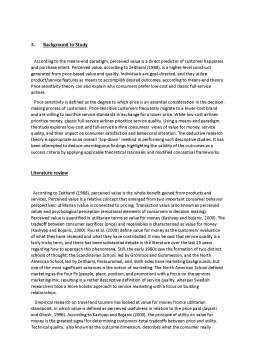Cuprins
- 1. Introduction
- 2. Aims and objectives
- 3. Background to study
- 4. Literature review
- 5. Research methodology
- 6. Data analysis
- 7. Conclusions
- 8. Research outcome
- 9. Reference page
Extras din referat
1. Introduction
Through the last twenty years the European airline industry has changed radically. Liberalization and deregulation, commencing in the early ‘90s, broke with the earlier bilateral agreements between the European governments and the restricted number of airlines. The new liberalized market conditions gave birth to a new distinction among the players in the industry being either FSC (Full service carriers) or LCC (Low cost carriers) - which characterizes aviation of today (York Aviation, 2007). Where FSC are focused on delivering wide services offerings and upgrades for customers willing to pay premium, the LCC business is quite the opposite, focusing on price as the key competitive factor.
Research shows that 85% of all leisure passengers buy tickets based on price and only about 15% are loyal to a brand when the price is close to the competitors (Forbes, 2007).
.
2. Aims and Objectives
Aim: The present research study measures the level of service quality and customer satisfaction with low cost airlines.
Objectives:
1+2. The first section outlines the general research
3. Methodology: this section elaborates on the scientific approach in relation to service and quality. Qualitative and quantitative techniques will be applied
4. Data analysis::
- Focus group interview
- Self-administered questionnaire (people intercepted)
As indicated above, each of the techniques has its own purpose and will be elaborated in the following section explaining the research design.
5.Conclusions The low cost airlines generally fall short in matching the customers’ expected level of the in-flight service quality The largest gaps are found within on-time departure, competences in unexpected situations, prompt handling of requests/complaints plus cleanliness and functionality of the cabin facilities.
3. Background to Study
According to the means-end paradigm, perceived value is a direct predictor of customer happiness and purchase intent. Perceived value, according to Zeithaml (1988), is a higher-level construct generated from price-based value and quality. Individuals are goal-directed, and they utilize product/service features as means to accomplish desired outcomes, according to means-end theory. Price sensitivity theory can also explain why consumers prefer low-cost and classic full-service airlines.
Price sensitivity is defined as the degree to which price is an essential consideration in the decision-making process of customers. Price-sensitive customers frequently migrate to a lower-cost brand and are willing to sacrifice service standards in exchange for a lower price. While low-cost airlines prioritize money, classic full-service airlines prioritize service quality. Using a means-end paradigm, the study explores low-cost and full-service airline consumers' views of value for money, service quality, and their impact on consumer satisfaction and behavioral intention. The deductive research theory is appropriate as an overall "top-down" method in performing such descriptive studies. It has been attempted to deduce unambiguous findings highlighting the validity of the outcomes as a success criteria by applying applicable theoretical rationales and modified conceptual frameworks.
Literature review
According to Zeithaml (1988), perceived value is the whole benefit gained from products and services. Perceived value is a relative concept that emerged from two important consumer behavior perspectives: utilitarian (value is connected to pricing; Transaction value (also known as perceived value) and psychological perception (emotional elements of consumers in decision making). Perceived value is quantified in utilitarian terms as value for money (Kashyap and bojanic, 2000). The tradeoff between consumer sacrifices (price) and receivables is characterized as value for money (Kashyap and Bojanic, 2000). Ryu et al. (2008) define value for money as the customers' evaluation of what they have received and what they have contributed. It may be said that service quality is a fairly tricky term, and there has been substantial debate in the literature over the last 25 years regarding how to approach this phenomena. Still, the early 1980s saw the formation of two distinct schools of thought: the Scandinavian School, led by Grönroos and Gummesson, and the North American School, led by Zeithaml, Parasuraman, and. Both sides have marketing backgrounds, but one of the most significant variances is the notion of marketing. The North American School defined marketing as the four Ps (people, place, position, and promotion) with a focus on the services marketing-mix, resulting in a rather descriptive definition of service quality, whereas Swedish researchers took a more holistic approach to service marketing with a focus on building relationships.
Bibliografie
Grönroos, C. (1988): Service quality: the six criteria of good perceived service quality, Review of
Business 3, 10-13
Grönroos, C. (1983): Strategic Management and Marketing in the Service Sector, Marketing Science
Institute, report no. pp. 83-104, Massachusetts
Grönroos, C. (1984): A service quality model and its marketing implications, European Journal of
Marketing 18, pp. 36-43
Zeithaml, V.A., Berry, L.L., & Parasuraman, A. (1993): The Nature and Determinants of Customer
Expectations of Service, Journal of the Academy of Marketing Science 21, 1
Gummesson, E. & Grönroos, C. (1987): Quality of Products and Services - a Tentative Synthesis
between Two Models, Services Research Centre, University of Karlstad, n.18, Sweden
Kossmann, M. (2006): Delivering Excellent Service Quality in Aviation, Ashgate Publisihing Limited,
England
Holloway, S. (2008): Straight and level: Practical Airline Economics, 3rd edition, Ashgate publishing limited
Hill, N. et al. (2003): How to Measure Customer Satisfaction, 2nd edition, Gower Publishing Limited,
Hampshire, England
Kasper, H. et al. (2006): Services Marketing Management - A Strategic Perspective, 2nd edition, John
Wiley & Sons Ltd
Zeithaml, V.A., et al (1990): Delivering Quality Service - Balancing Customer Perceptions and
Expectations, The Free Press, Macmillan, Inc.
Preview document
Conținut arhivă zip
- Research methods.docx
















